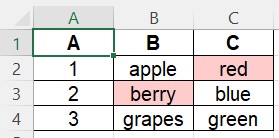如何突出大熊猫两种数据框架的差异
如何突出大熊猫两种数据框架的差异
提问于 2022-01-03 12:56:16
我在熊猫中有两个相同列的数据框架,我们在A列有索引
实际:
A B C
1 apple red
2 berry blue
3 grapes green第二数据帧
预期:
A B C
1 apple green
2 guava blue
3 grapes green现在我需要比较这两个数据帧,突出不匹配的单元格和在数据帧中,然后输出到excel。
我的代码:
import pandas as pd
pd.concat([pd.concat([actual,expected,expected]).drop_duplicates(keep=False)]).to_excel(.......)产出:
A B C
1 apple red
2 berry blue我需要突出红色和浆果
回答 2
Stack Overflow用户
发布于 2022-01-03 14:15:48
有一个函数- compare,它帮助您比较两个数据集:https://pandas.pydata.org/docs/reference/api/pandas.DataFrame.compare.html
df = pd.DataFrame({
"A": [1, 2, 3],
"B": ["apple", "berry", "grapes"],
"C": ["red", "blue", "green"]
},
columns=["A", "B", "C"])
df2 = df.copy()
df2.loc[0, 'C'] = 'green'
df2.loc[2, 'B'] = 'guava'使用它,您可以得到两个数据集的比较:
df.compare(df2)给你:
B C
self other self other
0 NaN NaN red green
2 grapes guava NaN NaN通过筛选不需要的行(相同的行)和列,您可以只使用与原始数据不同的数据来获得dataframe:
compare = df.compare(df2, keep_shape=True).drop('other', level=1, axis=1)
compare = compare.droplevel(1, axis=1).dropna(how='all')
A B C
0 NaN NaN red
2 NaN grapes NaN因为我们需要过滤原始数据集中相同的行:
filtered = df.loc[compare.index]现在,我们可以以某种方式“突出”不同的数据:
def color_cells(s):
if pd.notna(s):
return 'color:{0}; font-weight:bold'.format('red')
else:
return ''
filtered.style.apply(lambda x: compare.applymap(color_cells), axis=None)会产生这样的东西:

Stack Overflow用户
发布于 2022-01-03 14:29:55
使用StyleFrame可以很容易地做到这一点,如本文所示:color specific cells in excel python。
首先,运行pip安装样式框架。然后按照以下步骤操作:
from styleframe import StyleFrame, Styler
import pandas as pd
# true and expected data
d_true = {'A':[1,2,3], 'B':['apple', 'berry', 'grapes'], 'C':['red', 'blue', 'green']}
df_true = pd.DataFrame(d_true)
d_exp = {'A':[1,2,3], 'B':['apple', 'guava', 'grapes'], 'C':['green', 'blue', 'green']}
df_exp = pd.DataFrame(d_exp)
# pass df to styleFrame
sf1 = StyleFrame(df_true)
sf2 = StyleFrame(df_exp)
# Set color for differences
sf1_diff = Styler(bg_color='#FFCCCC') # red
sf2_diff = Styler(bg_color='#DAF6FF') # blue
# Difference matrix
ne = sf1.data_df != sf2.data_df
# apply above color style where difereneces are true
for col in ne.columns:
sf1.apply_style_by_indexes(indexes_to_style=ne[ne[col]].index,
styler_obj=sf1_diff,
cols_to_style=col)
sf2.apply_style_by_indexes(indexes_to_style=ne[ne[col]].index,
styler_obj=sf2_diff,
cols_to_style=col)
# save your excel
sf1.to_excel('df1_diff_in_color.xlsx').save()
sf2.to_excel('df2_diff_in_color.xlsx').save()输出excel文件:

页面原文内容由Stack Overflow提供。腾讯云小微IT领域专用引擎提供翻译支持
原文链接:
https://stackoverflow.com/questions/70566100
复制相关文章
相似问题

